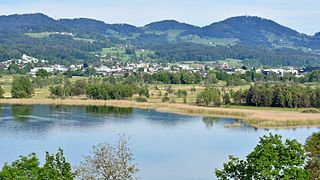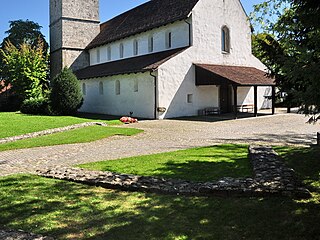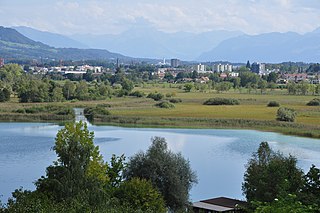
Wetzikon is a small town in the Zurich Highlands area of Switzerland, in the district of Hinwil in the canton of Zürich.

The Zürcher Oberland in Switzerland, is the hilly south-eastern part of the canton of Zürich, bordering on the Toggenburg, including the districts of Uster, Hinwil, Pfäffikon as well as the Töss Valley as far as the district of Winterthur. The territory gradually fell under the control of the city of Zürich from 1408 to 1452. In the 18th century, the jurisdiction lay with the reeve of Grüningen for the southern part, and with the reeve of Kyburg for the northern part together with most of the Zürcher Unterland.

Pfäffikon is a municipality in the canton of Zürich in Switzerland. It is the seat of the district of the same name. It is not to be confused with Pfäffikon SZ on Lake Zurich but in the canton of Schwyz.

Pfäffikersee is a lake in the canton of Zürich, Switzerland, near the town of Pfäffikon. It is 2.5 km long and 1.3 km wide at the middle. The lake was created in the last ice age when a moraine blocked off the ability for the lake to empty north towards Winterthur. There is also a hiking trail around the lake that people often bike and walk on, and the area is considered protected lands, among them the Robenhauser Ried and the prehistoric settlement Wetzikon–Robenhausen, discovered and researched by Jakob Messikommer (1828–1917), which became a serial site of the UNESCO World Heritage Site Prehistoric pile dwellings around the Alps. In Roman era, along Pfäffikersee there was a Roman road from the vicus Centum Prata (Kempraten) on Obersee–Lake Zürich via Vitudurum (Oberwinterthur) to Tasgetium (Eschenz) to the Rhine. To secure this important transport route, the Irgenhausen Castrum was built.

Villa rustica was the term used by the ancient Romans to denote a farmhouse or villa set in the countryside and with an agricultural section, which applies to the vast majority of Roman villas. In some cases they were at the centre of a large agricultural estate, sometimes called a latifundium. The adjective rustica was used only to distinguish it from a much rarer sub-urban resort villa, or otium villa built for purely leisure and luxury, and typically located in the Bay of Naples. The villa rustica would thus serve both as a residence of the landowner and his family and also as a farm management centre. It would often comprise separate buildings to accommodate farm labourers and sheds and barns for animals and crops.

Kempraten-Lenggis is a village (Kirchdorf) within the municipality of Rapperswil-Jona, Wahlkreis (constituency) of See-Gaster in the canton of St. Gallen in Switzerland. The remains of the Gallo-Roman settlement Centum Prata are one of the most important archaeological sites in the canton of St. Gallen; Centrum Prata is located at the so-called Kempratnerbucht, in Rapperswil and Busskirch on Zürichsee lake shore.

Pfannenstiel is a wooded mountain respectively a region overlooking the Lake Zürich and Zürcher Oberland in the canton of Zürich in Switzerland.

The S3 is a regional railway service of the Zürich S-Bahn on the Zürcher Verkehrsverbund (ZVV), the Zürich transportation network. It is operated by Swiss Federal Railways.

Auslikon is a village of the municipality of Pfäffikon in the canton of Zurich in Switzerland.

Irgenhausen is a village of the municipality of Pfäffikon in the canton of Zurich in Switzerland.

Kempten is a locality of the municipality of Wetzikon in the canton of Zurich in Switzerland.

The Wetzikon–Meilen tramway was a metre gauge rural electric tramway in the Swiss canton of Zürich. It linked the town of Meilen, on the shore of Lake Zürich, with Wetzikon and Kempten in the Zürcher Oberland.

Turicum was a Gallo-Roman settlement at the lower end of Lake Zurich, and precursor of the city of Zürich. It was situated within the Roman province of Germania Superior) and near the border to the province of Raetia; there was a tax-collecting point for goods traffic on the waterway Walensee–Obersee-Zürichsee–Limmat–Aare–Rhine.

Zürcher Oberländer, commonly shortened to ZOL, is a Swiss German-language daily newspaper, published in Wetzikon.

Robenhausen is a locality in Wetzikon, one of the municipalities of the canton of Zürich, Switzerland. The wetland Robenhauser Ried belongs to the protected area surrounding Pfäffikersee. The prehistoric pile dwelling around Lake Zurich Wetzikon-Robenhausen is part of the UNESCO-defined World Heritage Sites, the prehistoric pile dwellings around the Alps.

Vitudurum is the name of a Roman vicus, those remains are located in Oberwinterthur, a locality of the municipality of Winterthur in the canton of Zürich in Switzerland.

Wetzikon–Robenhausen is one of the 111 serial sites of the UNESCO World Heritage Site Prehistoric pile dwellings around the Alps, of which are 56 located in Switzerland. The site is located on Pfäffikersee lakeshore in Robenhausen, a locality of the municipality of Wetzikon in the Canton of Zürich in Switzerland.

Jakob Messikommer was a Swiss archaeologist who among others discovered and researched the UNESCO serial site Wetzikon–Robenhausen.

Jakob Heusser-Staub was a Swiss industrialist and philanthropist. Born and raised in the village of Irgenhausen, Heusser-Staub made Uster his home. With the support of his wife, Berta, he founded the Heusser-Staub foundation.

The Church of Saint Francis is a Roman Catholic parish church located in Wetzikon, Switzerland.




























